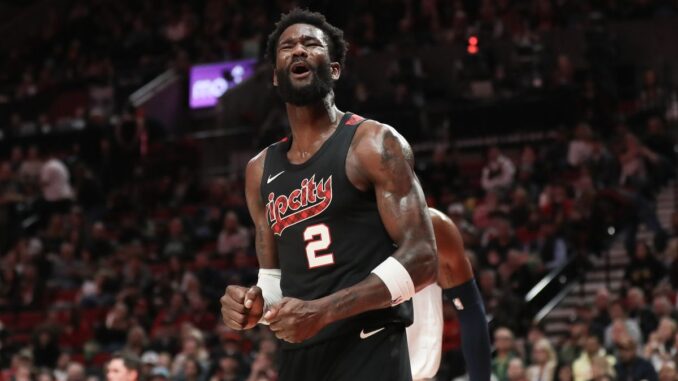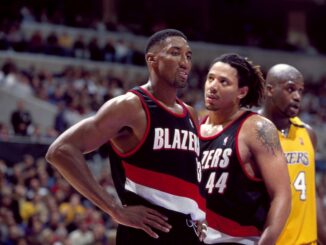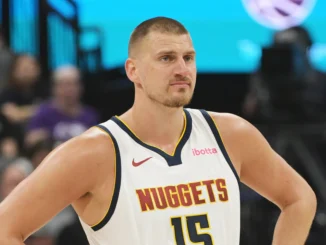
For the first time in nearly eight years, the Portland Trail Blazers are in a rebuild. For every Blazers’ great, there has been a Blazers’ great rebuild. For every exceptional season, what came before was an exceptional rebuild.
After Bill Walton, Portland rebuilt around Mychal Thompson. After Thompson, Portland rebuilt around Clyde Drexler. After Drexler, they rebuilt around Rasheed Wallace. After Wallace, they rebuilt around Brandon Roy. After Roy, they rebuilt around Damian Lillard. And after Lillard, they are rebuilding around Scoot Henderson.
It may be a vicious cycle, but it’s still a cycle. Enjoy your heroes while you can, but expect to go through a rebuild very soon after they play their final game, or in some cases before.
What can we learn from past rebuilds, and what might we expect in the new one? Bryant Knox (BK) and Casey Mabbott (CM) offer their thoughts on those questions.
For fans born after 1990, this is likely the first major rebuild they have experienced at a cognitive level where a living Blazers legend was traded to another team, and the front office hit the reset button. That same legend probably got a lot of young locals interested in the sport for the first time. What advice would you give younger fans as they watch a very new version of their team?
CM: Take lots of deep breaths; it’s probably going to be at least a couple of years until this is a playoff team, and possibly more before they can transform into an elite team going deep in the playoffs. Rebuilds require a few years to return to being an elite team. And keep in mind that they won’t always get back to the level they were at before the rebuild. Those who expect to get a championship out of this might just be disappointed, but if you were born after 1974, you probably weren’t old enough to witness the last one, not with lasting memories anyway.
That doesn’t mean this new team won’t be fun to watch, and it doesn’t mean they won’t win a lot of games – they might just lose a lot, also. It probably didn’t hurt that the last two seasons were pretty bad; these next couple probably won’t be as big of a culture shock to some fans as some of the previous rebuilds were after some of the biggest success stories this franchise has. If the last couple of years did anything, it’s making the roller coaster more of a bumpy car ride instead of a steep drop.
BK: Embrace Barney Stinson’s one rule: New is always better. Okay…it’s not exactly that simple. Winning a title with the face of your franchise would have been better. But there comes a time for every NBA fan base where embracing change is the best option.
In Rip City, fans have a unique situation. We’ve just said goodbye to maybe the greatest player ever to wear the jersey, yet there’s genuine reason for optimism across the league’s second-youngest team (which now also owns plenty of future draft capital).
In Portland, fans should recognize that despite the messy breakup, there is a lot of talent on display every night. Not every rebuild can say that. The wins will be tough to come by, it seems, and the product on the court will look its age for some grueling stretches. But at the end of the day, you have a team that’s easy to root for. And, yes—you can still root for Damian Lillard to find success, too.
Trading Clyde Drexler hurt, but at least he got to experience some of the things you would associate with generational superstars while in Portland. If you could change just one thing about the past, what experience would you add to Damian Lillard’s career? We aren’t changing the owner of championships, so don’t go that far. Our magic has limits.
CM: I would love to see Lillard play in an NBA Finals. We may get to see that in his new digs, but it would have been so great to see with Portland. Since we can only put him on the floor in a year the Western Conference did not win, let’s go with 2019. He would face the Toronto Raptors and play against prime Kawhi Leonard. I don’t think Portland will win that series, even if our magic is a little more powerful, but it would be really neat to see Dame get to fight for a title against one of the best players in his generation. It also means Portland gets past Golden State in the conference finals, and that’s just fine by me.
If we can’t put him in the Finals, I would love to see Dame in a three-point shootout with Steph Curry, Ray Allen, Reggie Miller, and Larry Bird – all in their best years. Let’s settle the “who is the greatest shooter” debate once and for all.
BK: Some will use this as an opportunity to spotlight why Portland should’ve dealt Damian Lillard years earlier before he ever forced his hand and requested a trade. But that’s not the play. The answer is that I wish Dame could play alongside another All-Star post-LaMarcus Aldridge. As good as CJ McCollum was and as good as Jusuf Nurkic could be, neither ever threatened All-Star status. Clyde had Terry Porter, Clifford Robinson, and Kevin Duckworth as All-Star teammates, but most importantly, they were All-Stars during Drexler’s prime, making the Blazers a team to fear beyond its No. 1.
To wish Dame had fellow All-Stars during his prime is really to wish Portland had been more willing to wheel, deal, and take risks on the trade market. Former GM Neil Olshey proved he wasn’t willing or capable, so making a front-office change earlier and for basketball reasons might be what we wish would’ve happened.
As a fan, was the 1995-96 season or 2011-12 season more difficult to experience? This was after seeing the final game for Drexler in February 1995 and the final game for Brandon Roy in April 2011.
CM: Roy was tougher to experience because it felt like that team was just finding its way in the league – and then had their legs cut out from under them, quite literally. They had some tough times in the playoffs, but Wesley Matthews and Nicolas Batum were turning into legit two-way players. There was still work to do on the roster, but it felt like they were maybe a year or two away from going after the title contenders.
Seeing Drexler in another team’s uniform wasn’t fun, but he won a title with his college teammate for his hometown team; it’s not every day you get a movie script ending like that. Drexler helped Portland get to the Finals twice, and they haven’t been back since. Knowing he was that great makes you appreciate his accomplishments, but it also means you want to be happy for him when the dust settles. If Dame wins a title for another team (anyone but the Lakers or Warriors, please!) I will be happy for him also.
BK: Clyde Drexler leaving for greener pastures was tough and not unlike watching Dame Time run out. But for me, watching Brandon Roy’s dominance, and ultimately his career, come to an end so prematurely will always be more painful. That’s largely because of the “What-Ifs” that come with the BRoy story, but it’s also because of the fact that the 2011-12 season, which involved a re-tooling attempt to avoid a full teardown, ended up a complete disaster—and ironically in a full teardown.
Both rebuilds we’re talking about went in directions nobody could’ve predicted in Year 1 without their superstars. But knowing that 2011-12 was a byproduct of both Roy and Greg Oden’s injuries made it feel less like a missed opportunity and more like the universe saying this is why we can’t have nice things.
What was your initial reaction to the front office drafting Scoot Henderson, and did that impact how you viewed the team trading away Lillard and Jusuf Nurkic?
CM: I liked the pick; it was the right move if there wasn’t a trade partner willing to give you a legitimate second star for Dame to share the court with. If anything, it made smashing the rebuild button make more sense once the front office shared with Dame they didn’t think they could build around him anymore. Whether they really meant they couldn’t or wouldn’t doesn’t matter; the amount of assets it would have cost them to bring in another star wouldn’t have made sense. He would go from a bottom-tier team with one star to a middle-tier team with two stars and no depth. We’ve seen that script play out before. It made more sense to start over and get him to a legit contender.
BK: I think I had convinced myself ahead of the draft that Scoot Henderson would never wear a Blazers jersey simply because Joe Cronin wouldn’t be able to resist a Zion Williamson trade or an OG Anunoby deal. Anything to keep Dame Time going in Portland was worth the No. 3 pick, right? But once it was clear Cronin was keeping the selection, the thought process changed, starting with mental gymnastics to believe Dame, Scoot, Simons, and Sharpe all made sense together, ending with the reality check that a new era was underway.
I’ll say this, though: I don’t know if Scoot himself changed how I view the Dame situation at large because I think Lillard still asks out if the Blazers draft Brandon Miller or Amen Thompson. Positional overlap wouldn’t be a concern in those scenarios, but it feels like this summer really came down to “trade the pick” or “trade Dame.” Getting Scoot out of the deal was the best scenario for Portland if a draft-night deal was never going to happen, making swapping Nurkic for a more athletic, timeline-appropriate center in Deandre Ayton an even better move in the end.
Rebuilds often mean multiple deals and shuffling of assets, and this is done over multiple seasons. The Blazers have made three deals so far. Would you prefer to see them make more deals this season or hold off to let their new core play together?
CM: I would like to see them close out this season with the starting lineup they have, at least, but no issue if they want to trade role players or picks for better options down the road. At some point, you have to wait and see what you have. If you keep throwing players around, it is tough to gel, and you can’t give a fair grade to what you see in games.
This team has a lot of talent on paper, but they are having trouble staying healthy, and most of their core are unproven guys who need time to develop and adapt to the pro game. Another deal at this point will only tell the guys you have that they are only valuable as trade bait, which is not a good message for so many young players. The front office is obligated to give the guys they bring in a chance to prove they belong on this team before they flip them to another team for future picks.
BK: I think a Malcolm Brogdon deal gets done this season. He’s too good for a contender not to swoop in before the deadline and too good for a Blazers team that becomes more incentivized to tank with every passing thumb, ankle, and knee injury.
The downside to flipping Brogdon so soon is that you still need adults in the room. You must also taste winning occasionally, even as a tanking team, to keep the vibes good and potential long-term pieces on the same page. But that’s why Jerami Grant should not be shopped this season. He alone isn’t getting this group to the next level despite taking pressure off a backcourt that, once healthy, will be let loose. That’s exactly what the new-look Blazers need.
Looking beyond this season, it shouldn’t be surprising if Grant does end up on a contender at some point in exchange for—you guessed it—future assets. After all, this year is about sorting future pieces, and next season will be when Cronin starts putting together the puzzle. But there’s another name that many don’t want to consider entering the tradesphere: Anfernee Simons. As the longest-tenured Blazer on the roster, Simons is also part of the old front-office regime. This isn’t a cry for Portland to start shopping maybe its best player immediately next season; however, it is a recognition that the current FO may prioritize players they’ve drafted in Scoot and Shaedon Sharpe (or traded for in Ayton). If that’s the case, Simons could be the centerpiece of a deal that helps bolster the frontcourt.
It’s uncomfortable to think about, but it comes with the territory in every major rebuild. Not all old pieces will fit the new puzzle. For now, though, I’d expect a Brogdon deal and not much else.



